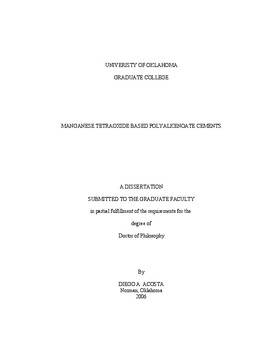| dc.contributor.advisor | Grady, Brian P., | en_US |
| dc.contributor.author | Acosta, Diego A. | en_US |
| dc.date.accessioned | 2013-08-16T12:20:22Z | |
| dc.date.available | 2013-08-16T12:20:22Z | |
| dc.date.issued | 2006 | en_US |
| dc.identifier.uri | https://hdl.handle.net/11244/1083 | |
| dc.description.abstract | Polyalkenoate cements resulting from reaction between Mn3O4 with acrylic acid and poly(acrylic acid) have been analyzed by Fourier transform infrared spectroscopy (FTIR) and x-ray photoelectron spectroscopy (XPS). This reaction was carried out with and without aluminum chloride to see the impact of this cation on acid-metal coordination. Mn2+, as well as Al3+, coordinate with the organic acids (i.e., acrylic acid and poly(acrylic acid)), and the soluble metal cations promote hardening of the material. In the case of acrylic acid, the addition of an azo initiator causes free radical polymerization which is also necessary for hardening of the polyalkenoate cement. | en_US |
| dc.format.extent | viii, 67 leaves : | en_US |
| dc.subject | Rheology. | en_US |
| dc.subject | Engineering, Chemical. | en_US |
| dc.subject | Cement Additives. | en_US |
| dc.subject | Manganous oxide. | en_US |
| dc.subject | Cement slurry. | en_US |
| dc.title | Manganese tetraoxide based polyalkenoate cements. | en_US |
| dc.type | Thesis | en_US |
| dc.thesis.degree | Ph.D. | en_US |
| dc.thesis.degreeDiscipline | School of Chemical, Biological and Materials Engineering | en_US |
| dc.note | Adviser: Brian P. Grady. | en_US |
| dc.note | Source: Dissertation Abstracts International, Volume: 67-09, Section: B, page: 5240. | en_US |
| ou.identifier | (UMI)AAI3234987 | en_US |
| ou.group | College of Engineering::School of Chemical, Biological and Materials Engineering | |
